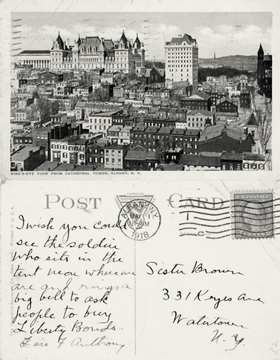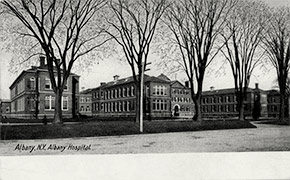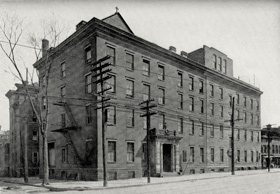Produced by the University of Michigan Center for the History of Medicine and Michigan Publishing, University of Michigan Library
Influenza Encyclopedia
The American Influenza Epidemic of 1918-1919:
A Digital Encyclopedia
Albany, New York
50 U.S. Cities & Their Stories
Like nearly every other East Coast city, Albany was struck by the influenza epidemic in late-September, 1918. It arrived quickly and with little warning. As physicians were not yet required to report cases, neither State nor local health officials had an accurate idea of just how many cases had developed in the city and surrounding areas. Although City Health Officer Dr. Arthur Sautter did not believe there were many cases in Albany, physicians in nearby towns were claiming hundreds of suspected cases. On September 27, New York State Health Commissioner Dr. Herman Biggs issued a letter to state newspapers, listing the symptoms and treatment of influenza and asking them to warn their readership to brace for the epidemic. He also asked all New York physicians to report at frequent intervals the prevalence of influenza and pneumonia in their localities.1
Initially, Health Officer Sautter was optimistic about the situation in Albany. On October 5, he declared that the city “[had] been unusually fortunate” compared to other cities across Upstate New York, and therefore closure orders would likely not be necessary. Two days later, however, he changed his tune when reports from local physicians indicated approximately 6,000 cases of influenza in Albany. Sautter now advocated for a general closure order if the influenza situation did not improve dramatically within a few days.2 The next day, on October 8, as dozens of new cases were reported, Albany Commissioner of Public Safety James Sheldon Frost, upon Sautter’s recommendation, ordered all schools, churches, theaters, movie houses, and libraries closed, and indoor public gatherings suspended, effective at 8:00 am on October 9. The City Council made it a misdemeanor to cough or sneeze in public without covering the mouth, with a whopping $500 fine and the possibility of a year in prison for offenders. Residents were warned not to spit in public or risk arrest and a $10 fine.3 The city’s orphanages closed their doors to visitors or new intakes. Albany buckled down for the epidemic.
Quickly the number of new cases mounted. When the city’s hospitals were overrun with patients ill with influenza and pneumonia, Sautter arranged to have the newly constructed Smallpox Hospital, with space for 100 patients, made available. The heads of Albany’s administrative departments lent as much aid as they could. The police chief had patrol cars drive patients to the hospitals. The president of the common council loaned his personal automobile as an ambulance. The school superintendent assigned school nurses to work for the Bureau of Health. Other, private citizens and organizations helped as well. The dean of Albany Medical College arranged to have his medical students provide on-call care to patients. The Guild for Public Health Nursing, the Catholic Women’s Service, and the Red Cross all lent their aid as well.4
By the third week of October, nearly 6,000 influenza cases had been reported in Albany. The number of new cases had been steadily declining, however, and Sautter believed the epidemic was essentially over and that the danger had passed. On October 23 he recommended to the city’s Board of Estimate and Apportionment that the closure order be lifted. The Board agreed. The next day, after only two weeks, Albany reopened. Schools and most movie houses were to remain closed until at least November 2, however, as concern remained that Albany’s youngsters were still at risk for contracting and spreading the disease. The city’s four performing arts theater–Harmanus Bleecker Hall, the Grand, the Empire, and the Majestic–catered to an adult crowd and were allowed to reopen along with the rest of Albany.5
By November 1, some 7,091 cases of influenza had been reported in Albany. Fortunately, the worst appeared to be over. Hospitals, once crowded, now had plenty of beds available. And, for the first time since the start of the epidemic, no hospital deaths were reported. Still, Sautter remained cautious. Fearing a second spike in cases if children were allowed back into their classrooms, he recommended to the Board of Estimate and Apportionment that schools be kept closed for an additional week. Theaters, he suggested, could reopen with little danger, provided they shorted their operating hours. The Board accepted Sautter’s recommendations and ordered Albany’s schools to remain shut until at least November 9, and allowed theaters to operate from 7 pm to 11 pm starting Thursday, November 7.6
On Monday, November 11, Albany’s theaters reopened for normal operating hours and children returned to their classrooms. All classrooms were disinfected, and school nurses inspected each student for illness before admitting them. Overall, only a few students were found ill with influenza. With the last of the epidemic orders now removed, life in Albany slowly returned to normal.
For some residents, however, the aftermath of the epidemic would be felt for some time to come. Over 450 Albany citizens died during the epidemic. Hundreds of children had lost at least one parent to influenza, and at least fifty had been completely orphaned. The city’s orphanages still under protective sequestration, however, so these cases could not be placed. The Catholic diocese offered the use of its School of Mothers and the Cathedral settlement house for these children, some of who had influenza themselves.7 The St. Elizabeth’s Guild opened its doors to orphans as well when even more were discovered amongst Albany’s children. The Associated Charities of Albany also pitched in, inspecting homes of those still convalescing in hospitals before they were discharged and distributing food to the sick.8 Together, these organization, public officials, and private citizens slowly pieced together life in Albany.
Notes
1 “Two Soldiers Are Influenza Victims,” Albany Evening Journal, 2 Oct. 1918, 1.
2 “Albany Officials Confident,” Albany Knickerbocker Press, 5 Oct. 1918, 2; “Albany Reports 600 Grip Cases,” Albany Knickerbocker Press, 7 Oct. 1918, 1.
3 “Order of Frost Barring Indoor Gatherings,” Albany Knickerbocker Press, 9 Oct. 1918, 1; “Epidemic Crusade Started by State,” Albany Evening Journal, 12 Oct. 1918, 16.
4 “Report of the Department of Health,” in Proceedings of the Common Council, Vol. II: Message of the Mayor and Reports of City Officers (Albany: Argus Printers, 1918), 236-237.
5 “Closing Ban Has Been Modified,” Albany Evening Journal, 23 Oct. 1918, 1.
6 “Flu Ban on Schools to be Continued Next Week,” Albany Evening Journal, 2 Nov. 1918, 1.
7 “City Will Care for flu Victims’ Orphans,” Albany Evening Journal, 4 Nov. 1918, 2; “Caring for Little Ones Left Orphans by the Epidemic of Influenza,” Albany Evening Journal, 13 Nov. 1918, 10.
8 “Influenza After Care System Organized,” Albany Evening Journal, 5 Nov. 1918, 3.








